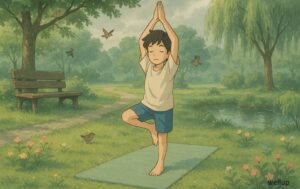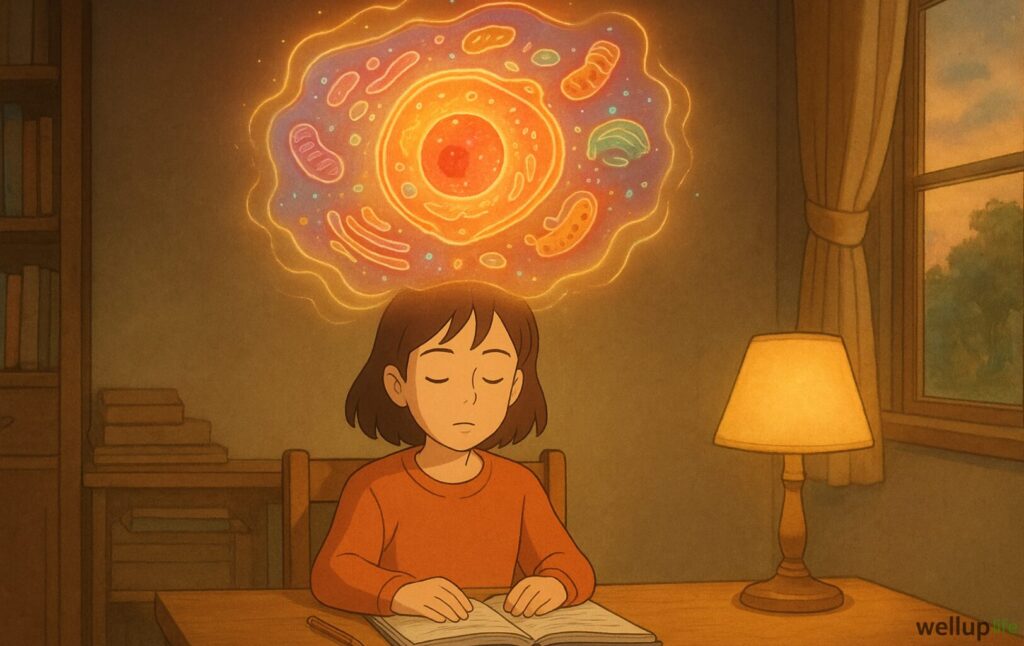Being a teenager today isn’t easy. Between school pressure, endless social media notifications, and the constant push to “fit in,” it’s no wonder so many teens feel anxious, distracted, or overwhelmed. In fact, research shows that stress levels among teens are rising faster than ever before, and it often shows up as restlessness, poor sleep, or even panic before exams.
A Swedish study spanning 1993 to 2017 found that school-related stress in 15-year-olds more than doubled, especially among girls, highlighting how today’s adolescents face more pressure than ever before [1]School stress in 15-year-olds has more than doubled since the 1993.
Stress doesn’t stay in the mind—it often shows up physically. In Chennai, researchers discovered that a staggering 84.8% of school-going adolescents felt academically overloaded, and 23.5% reported sleep disturbances, showing a clear link between increased stress and poor sleep hygiene [2]Over 84% of adolescents feel academic overload and 23.5% report sleep disturbances.
This is where mindfulness exercises for teens can make a real difference. Mindfulness isn’t about sitting cross-legged for hours or “emptying the mind.” Instead, it’s about learning simple ways to pause, notice the present moment, and reset the mind when life feels too heavy.
In this guide, we’ll explore 10 practical mindfulness exercises for teens—from quick breathing techniques to fun classroom activities—that actually work. Whether you’re a parent hoping to calm your teen’s stress, a teacher wanting to bring focus into the classroom, or a teen yourself looking for easy ways to manage anxiety, these exercises are designed to fit into everyday life.
What Are Mindfulness Exercises?
At its core, mindfulness simply means paying attention to the present moment without judgment. Instead of getting caught up in worries about the future or regrets about the past, mindfulness brings awareness back to what’s happening right now—our breath, our thoughts, or even the way our body feels.
Mindfulness exercises are practical activities that help us train this awareness. These can be as simple as taking three deep breaths, slowly eating a piece of chocolate while noticing its taste and texture, or scanning your body to release hidden tension. The goal isn’t to “empty the mind” but to notice thoughts and feelings with kindness rather than letting them take over.
Studies show that regular mindfulness practice can reduce anxiety, improve concentration, and support emotional well-being [3]American Psychological Association – Mindfulness practice linked to stress reduction.
For teens especially, mindfulness exercises are powerful because they don’t require special equipment or long hours of practice—just a few minutes of focused attention can make a noticeable difference.
Why Teens Need Mindfulness Exercises?
Teen years are full of challenges—academic pressure, endless social media scrolling, shifting friendships, and the search for identity. While these years can be exciting, they’re also a time when stress, anxiety, and overthinking often peak. In fact, studies suggest that nearly one in three adolescents will experience an anxiety disorder before they reach adulthood [4]National Institute of Mental Health – Adolescent Mental Health Statistics.
This is where mindfulness becomes more than just a “wellness trend.” Practicing mindfulness helps teens:
- Manage anxiety by grounding themselves in the present.
- Improve focus and memory, which is especially useful during study sessions or exams.
- Develop emotional resilience by noticing thoughts without reacting instantly.
- Build healthier relationships through empathy and mindful listening.
Example To Understand
Imagine a 16-year-old student sitting nervously before a math exam. Their heart is racing, palms are sweaty, and the mind is flooded with “What if I fail?” thoughts. Instead of spiraling, they pause for a 3-minute breathing exercise—inhale deeply, exhale slowly, and simply notice each breath. Within minutes, their body relaxes, and the racing thoughts begin to settle. The exam might still be challenging, but they now face it with clarity and calm rather than panic.
This simple practice shows how even a few minutes of mindfulness can shift a teen’s mindset from chaotic to calm.
10 Best Mindfulness Exercises for Teens (Step-by-Step Guide)
Mindfulness doesn’t have to be complicated. In fact, the best exercises are often short, simple, and practical—perfect for busy teens. Below, we’ll explore 10 mindfulness techniques designed specifically for teenagers, with step-by-step instructions that make them easy to try anytime.
1. The 5-4-3-2-1 Grounding Technique
This exercise is one of the quickest ways for teens to manage sudden anxiety, overthinking, or panic. It uses the five senses to bring attention back to the present moment.
How to Practice:
- Pause and look around you. Take a slow, deep breath.
- Notice 5 things you can see. (Example: the color of your notebook, the light from a lamp, a poster on the wall.)
- Notice 4 things you can touch. (Example: your chair, your pen, the fabric of your clothes, the desk.)
- Notice 3 things you can hear. (Example: birds outside, your own breathing, faint classroom sounds.)
- Notice 2 things you can smell. (Example: food nearby, perfume, fresh air from an open window.)
- Notice 1 thing you can taste. (Maybe gum, toothpaste, or just the taste in your mouth.)
- Take one final slow breath and gently bring your focus back.
Why It Works:
This simple yet powerful technique helps teens interrupt racing thoughts and calm the nervous system. By focusing on the senses, the brain shifts away from stress triggers and into the safety of the present moment [5]Anxiety & Depression Association of America – Grounding techniques for anxiety.
When to Use It:
- Before a test or class presentation
- During a stressful conversation with friends
- Anytime negative thoughts feel overwhelming
Tip for Teens: You can practice this mindfulness exercise silently, and no one will even notice—making it perfect for classrooms or crowded places.
2. Mindful Breathing (3 Minutes)
Breathing is something we do all day without thinking—but when done mindfully, it becomes a powerful tool to calm the mind and body. For teens, this exercise is especially useful during moments of stress, nervousness, or even before sleep.
How to Practice:
- Find a comfortable spot. Sit upright in a chair or cross-legged on the floor. Close your eyes if you feel comfortable.
- Take a deep breath in through your nose. Count slowly to 3 as your lungs fill with air.
- Exhale slowly through your mouth. Count to 3 again, noticing the air leaving your body.
- Focus only on the rhythm of your breath. If thoughts pop up (and they will), gently bring attention back to breathing.
- Continue for 3 minutes. You can set a timer or just count 10–12 breaths.
Why It Works:
Breathing mindfully sends signals to the brain that it’s safe, which reduces the “fight or flight” response. Research shows that mindful breathing helps lower stress, improve attention, and regulate emotions [6]Harvard Health Publishing – Mindful breathing can reduce stress.
When to Use It:
- Right before an exam or presentation
- After an argument or a stressful day
- Before bedtime to fall asleep faster
Tip for Teens: If focusing feels hard, try silently saying “in” when you breathe in and “out” when you breathe out. This little trick makes it easier to stay present.
3. Body Scan Relaxation
Sometimes stress shows up not just in the mind but also in the body—tight shoulders, clenched jaw, or a heavy chest. The body scan relaxation exercise helps teens release this hidden tension by mindfully checking in with each part of the body. It’s one of the most effective mindfulness exercises for relaxation and can be done lying down or sitting comfortably.
How to Practice:
- Find a quiet place. Sit or lie down in a comfortable position. Close your eyes if you feel safe doing so.
- Take a deep breath. Inhale slowly through your nose, exhale through your mouth.
- Start with your toes. Notice how they feel. Are they tense? Relax them.
- Move up slowly. Bring attention to your legs, stomach, back, arms, shoulders, neck, and face. At each point, pause for a moment and release any tension.
- Breathe into tight areas. If you notice stress in your shoulders or jaw, take a breath and imagine the tension melting away.
- Finish with a full-body awareness. Picture your whole body calm, light, and relaxed.
Why It Works:
Body scanning teaches teens to notice stress signals in their body early—before they turn into headaches, fatigue, or irritability. Research shows that body scan meditation can reduce stress and improve sleep quality [7]National Center for Biotechnology Information – Body scan meditation and stress reduction.
When to Use It:
- After a long school day, to unwind
- Before sleeping to relax the body
- During anxious moments when tension builds up
Tip for Teens: Pair this with calming music or a guided body scan audio (many free versions are on YouTube) to make it even more soothing.
4. Mindful Journaling
Writing can be one of the most powerful mindfulness exercises for teens, especially when emotions feel overwhelming. Journaling helps process thoughts, release stress, and notice patterns in feelings—without judgment. Unlike regular writing, mindful journaling focuses on awareness and reflection rather than perfection.
How to Practice:
- Find a quiet spot. Sit with a notebook and pen (or even a notes app).
- Set a timer for 5–10 minutes. This keeps journaling short and manageable.
- Take 2 deep breaths. Ground yourself before writing.
- Choose a prompt (see below) and write freely—don’t worry about grammar or making it “sound good.”
- End with gratitude. Write down one small thing you’re thankful for today.
Mindful Journaling Prompts for Teens:
- “Right now, I feel…”
- “One thought I want to let go of is…”
- “Something small that made me smile today is…”
- “When I notice my stress, it feels like…”
- “Three things I’m grateful for are…”
Why It Works:
Journaling creates a safe outlet for emotions and helps teens observe their thoughts instead of being controlled by them. Research shows that expressive writing reduces anxiety and improves overall well-being [8]Positive Psychology – Expressive writing and its mental health benefits.
When to Use It:
- Before bed to “empty the mind” for better sleep
- After a stressful day at school
- When feeling stuck in negative thoughts
Tip for Teens: If writing feels hard, start by just listing 3 emotions you’re feeling—sometimes even naming them can bring relief.
5. Gratitude Practice
Gratitude may sound simple, but it’s one of the most powerful mindfulness activities for teens. By focusing on what’s going right—rather than what feels stressful—teens can train their minds to notice the positives in everyday life. Over time, this shift builds resilience, optimism, and emotional balance.
How to Practice:
- Take a deep breath. Pause and clear your thoughts for a moment.
- Think of 3 things you’re grateful for today. They don’t have to be big—it could be a good meal, a friend’s text, or even your favorite song.
- Write them down in a notebook or say them silently to yourself.
- Feel the gratitude. Spend a few seconds actually noticing how it feels when you think of these things.
- Repeat daily. Morning or night works best.
Why It Works:
Research shows that gratitude practice boosts happiness, reduces stress, and improves mental health—especially in young people [9]Greater Good Science Center – The Science of Gratitude. For teens, this simple exercise shifts focus away from social comparison and stress, and onto appreciation.
When to Use It:
- At night, before going to bed
- After a tough day, to reset perspective
- As a quick daily habit for positivity
Tip for Teens: Keep a “gratitude jar.” Each day, write one thing you’re thankful for on a small paper slip and drop it in. On hard days, open the jar and read a few notes—you’ll instantly remind yourself of the good around you.
6. Mindful Eating (Chocolate or Fruit Exercise)
Eating is something we all do every day—but how often do we really taste our food? Teens often snack while scrolling or rushing, which means they miss the calming power of eating mindfully. This mindful eating exercise teaches awareness, patience, and presence in a super relatable way.
How to Practice (Chocolate/Fruit Version):
- Pick your food. Choose a small piece of chocolate, a raisin, or a slice of fruit.
- Look closely. Notice the color, shape, and texture. Pretend you’ve never seen it before.
- Smell it. Take a slow breath in and notice any aromas.
- Take a tiny bite. Don’t rush. Let the food sit in your mouth before chewing.
- Chew slowly. Notice the flavor, texture, and how it changes as you chew.
- Swallow mindfully. Pay attention to how your body feels as you eat.
Why It Works:
This exercise helps teens develop a healthier relationship with food and trains the brain to focus on the present moment. Studies show mindful eating reduces stress eating, improves digestion, and enhances overall well-being [10]Harvard Health – Mindful eating: Savor the flavor.
When to Use It:
- As a calming break during study sessions
- At lunch, to slow down and reset
- To reduce emotional or “boredom” eating
Tip for Teens: Try mindful eating with your favorite snack—it makes even chips or chocolate taste richer when you really pay attention.
7. Visualization (Calm Place Meditation)
Sometimes our minds feel like a storm—homework, exams, friendships, social media, all swirling at once. Visualization meditation is a mindfulness exercise for teens that uses imagination to create calm. By picturing a safe, peaceful place, teens can reduce stress and reset their emotions.
How to Practice (Step-by-Step):
- Find a quiet spot. Sit or lie down comfortably.
- Close your eyes and breathe. Take 2–3 deep breaths to settle in.
- Imagine a calm place. It could be a beach, a forest, a mountain view, or even your cozy bedroom.
- Engage the senses.
- What do you see? (waves, trees, sky)
- What do you hear? (birds, wind, water)
- What do you feel? (sunlight, breeze, soft sand)
- Stay in this place. Rest there for 3–5 minutes, letting your body relax.
- Slowly return. Take a deep breath and gently open your eyes.
Why It Works:
Visualization is proven to reduce anxiety and activate the body’s relaxation response [11]Cleveland Clinic – Guided imagery for relaxation and stress relief. It’s especially useful for teens who feel overwhelmed by exams, social pressures, or racing thoughts.
When to Use It:
- Before exams or tests to calm nerves
- At night, when it’s hard to sleep
- Anytime stress feels overwhelming
Tip for Teens: Create a “go-to calm place” you can use every time. The more often you return to the same peaceful image, the easier it becomes to relax quickly.
8. Walking Meditation (Mindful Walking)
Walking is something we do without thinking. But when we slow it down and notice each step, it becomes one of the most powerful mindfulness exercises for teens. Walking meditation combines movement with awareness—perfect for restless energy or when sitting still feels impossible.
How to Practice (Step-by-Step):
- Choose a quiet path. A park, garden, or even a schoolyard works well.
- Stand still first. Take one deep breath, noticing how your feet feel on the ground.
- Start walking slowly. Pay attention to each step—heel, sole, toes touching the earth.
- Sync with your breath. Inhale as you take one step, exhale as you take the next.
- Notice your surroundings. Feel the breeze, hear the sounds, see the colors around you.
- If your mind wanders, gently bring it back to the rhythm of your steps.
Why It Works:
Walking meditation helps teens release stress, improve focus, and connect body with mind. Research shows mindful walking can reduce anxiety and promote better emotional regulation [12]NCBI – Effects of walking meditation on anxiety, depression, and stress.
When to Use It:
- During study breaks
- Before sports practice to center yourself
- Anytime you feel overwhelmed indoors
Tip for Teens: Try walking barefoot on grass for a few minutes—this simple “grounding” practice makes you feel even more connected to nature and calm.
9. Loving-Kindness Meditation (Metta Practice)
Sometimes the hardest person to be kind to is… ourselves. Loving-kindness meditation, also called Metta, helps teens replace negative self-talk with warmth and compassion. By silently sending good wishes to themselves and others, they cultivate empathy, peace, and emotional resilience.
How to Practice (Step-by-Step):
- Sit comfortably. Close your eyes and take a few deep breaths.
- Start with yourself. Silently repeat phrases like:
- “May I be happy.”
- “May I be healthy.”
- “May I be safe.”
- “May I live with ease.”
- Extend to loved ones. Think of a friend, parent, or mentor and repeat the same phrases for them.
- Include neutral people. Someone you know but don’t have strong feelings about (like a classmate).
- Even include difficult people. With practice, you can send kindness to those you have conflicts with.
- End with all beings. Imagine radiating love to everyone in the world.
Why It Works:
Studies show loving-kindness meditation reduces anxiety, increases positive emotions, and strengthens social connections [13]Greater Good Science Center – How loving-kindness meditation changes the brain. For teens, it’s a powerful tool to heal from self-doubt, bullying, or feelings of loneliness.
When to Use It:
- After an argument or hurt feelings
- When struggling with self-esteem
- As a morning practice to start the day with positivity
Tip for Teens: If saying the phrases feels awkward at first, just imagine sending a warm “hug of kindness” to yourself or others—it works just the same.
10. Mindful Monday Activities
Mondays can feel heavy for teens—new assignments, classes, and the stress of the week ahead. A Mindful Monday Routine helps start the week with clarity, calm, and focus. Instead of rushing, teens take small moments of mindfulness to set a positive tone for the next seven days.
Step-by-Step Mindful Monday Routine for Teens:
- Morning Gratitude (2 minutes)
- Before picking up your phone, think of 3 things you’re grateful for (friends, family, health, even small wins like a good breakfast).
- Gratitude reduces stress and boosts mood [14]Harvard Health – Giving thanks can make you happier.
- Mindful Breathing (5 minutes)
- Sit quietly, close your eyes, and take 10 slow breaths.
- Repeat a calming phrase like “I am ready for today.”
- Positive Intention Setting (2 minutes)
- Write down one positive intention for the day (e.g., “I will stay calm during challenges”).
- Mindful Eating at Breakfast
- Take the first 3 bites slowly—notice the taste, smell, and texture before scrolling or talking.
- Walking Meditation on the Way to School
- If possible, walk part of your route with awareness—feeling each step and breath.
- Evening Reflection (5 minutes)
- At night, jot down one thing that went well and one moment you stayed mindful.
Why It Works:
This simple 15–20 minute Monday routine blends gratitude, mindfulness, and journaling. It sets the tone for the week, reduces Monday stress, and helps teens feel more in control of their energy and mindset.
Tip for Teens: You don’t have to do it perfectly—just try one or two steps consistently, and build from there.
Tips for Parents & Teachers
Mindfulness is most effective for teens when the adults around them create a supportive environment. Parents and teachers are not just guides but also role models—teenagers notice more than they admit, and their stress responses often mirror the adults they live and learn with. In fact, research highlights that parental stress directly influences how children experience and handle stress themselves [15]APA – How parental stress affects kids.
This means that the first step in nurturing mindfulness in teens is to lead by example. When parents practice a few moments of calm breathing before dinner, or teachers open class with a quiet pause, teenagers are more likely to adopt mindfulness naturally, without it feeling forced. Below are some key strategies that parents and teachers can adopt.
1. Lead by Example
Teens notice far more than they say. When parents pause to take a few calming breaths before dinner, or teachers begin class with a short mindful moment, they demonstrate that mindfulness is not just talk—it’s a practice. Leading by example shows that slowing down is a strength, not a weakness.
2. Keep it Short and Simple
Lengthy meditation sessions may feel overwhelming for teens. Instead, quick practices—such as one minute of mindful breathing before exams or a short body scan after sports—can feel approachable. These small, repeatable moments give teens practical tools to manage stress without making mindfulness seem like a chore.
3. Create Supportive Environments
The environment in which mindfulness is practiced matters. At home, this could mean family meals without screens or a calming bedtime routine. At school, teachers can introduce short reflection breaks or designate a calm corner for students who need to reset. These small environmental cues reduce overstimulation and make mindfulness a natural part of the day.
4. Encourage Journaling and Reflection
Not every teen will enjoy meditation, but many connect with journaling. Giving teens a space to write down what they’re grateful for, or reflect on daily challenges, helps them process emotions. In classrooms, prompts like “What challenged you today?” encourage self-awareness. Journaling has been shown to reduce stress and improve emotional well-being [16]University of Rochester Medical Center – Journaling for mental health.
5. Avoid Pressure and Celebrate Small Wins
Mindfulness should never feel forced. When teens feel judged for “not doing it right,” they become resistant. Instead, parents and teachers can invite curiosity by asking gentle questions such as, “How did you feel after that exercise?” and celebrating small efforts. Over time, these little successes build consistency.
6. Connect Mindfulness to Hobbies
Mindfulness becomes more engaging when tied to what teens already enjoy. Music can be listened to mindfully by noticing instruments and lyrics, sports can be practiced with awareness of breath and movement, and art can be approached with slow, intentional strokes. Connecting mindfulness to hobbies makes it fun and personal.
7. Support Healthy Tech Habits
Technology is a huge part of teen life, and helping them use it mindfully is essential. Parents can encourage tech-free meals or a no-screen hour before bedtime. Teachers can guide students in reflecting on whether their online activities feel uplifting or draining. Introducing mindfulness apps like Calm or Headspace can also turn screen time into a positive experience.
By modeling calm behavior, keeping mindfulness simple, and weaving it into everyday routines, parents and teachers can create an atmosphere where teens not only learn about mindfulness but truly live it.
Common Challenges & How to Overcome Them
While mindfulness offers many benefits, teens may face obstacles when trying to practice regularly. Understanding these challenges—and knowing how to gently overcome them—can make the journey smoother and more rewarding.
1. “I Don’t Have Time”
With school, homework, sports, and social activities, teens often feel they have no time for mindfulness. The truth is, mindfulness doesn’t always require long sessions. Even one minute of deep breathing before an exam or a mindful walk between classes can make a difference. Parents and teachers can encourage “micro-moments” of mindfulness rather than setting strict, long practices.
Solution: Start small. Suggest brief exercises like mindful breathing for 60 seconds or noticing three things around them before opening a textbook. Over time, these tiny practices build into a habit.
2. Difficulty Staying Focused
Many teens report, “My mind keeps wandering” when trying mindfulness. This is completely normal—the brain is designed to think. The goal of mindfulness is not to empty the mind but to notice when it wanders and gently return to the present.
Solution: Use guided practices. Apps, videos, or a parent/teacher’s calm voice can help keep teens anchored. Activities that engage the senses—like mindful eating or listening to music—are also easier starting points for focus.
3. Feeling Self-Conscious
Some teens may feel embarrassed practicing mindfulness, especially around peers. They might see it as “weird” or worry about being judged.
Solution: Normalize mindfulness by making it a group activity. Teachers can introduce a one-minute breathing exercise at the start of class, or families can do a gratitude round at dinner. When it’s practiced openly, it becomes less intimidating.
4. Expecting Instant Results
Teens (and adults alike) often expect mindfulness to work like a quick fix. When stress doesn’t vanish immediately, they may feel it “doesn’t work.”
Solution: Shift expectations. Mindfulness is like exercise—it builds strength over time. Remind teens that the benefits, such as reduced anxiety or better focus, become noticeable after consistent practice. Celebrate small progress, like “I stayed calm during a tough moment today.”
5. Overreliance on Technology
Ironically, while there are great mindfulness apps, teens may struggle because they’re glued to devices in non-mindful ways. Endless scrolling fuels stress and distracts from present-moment awareness.
Solution: Encourage “mindful tech use.” This could mean setting limits on social media, practicing phone-free meals, or using mindfulness apps for short practices. Parents and teachers can guide them to reflect on how certain online activities make them feel.
6. Resistance or Lack of Interest
Not all teens will immediately connect with mindfulness. Some may see it as boring, unnecessary, or too “spiritual.”
Solution: Make it relatable. Instead of saying “Let’s meditate,” connect mindfulness to what they already enjoy—sports, art, music, or even gaming. For example, an athlete can practice mindful breathing before a match, while an artist can notice each brushstroke as a form of meditation.
Key Insight: Challenges are part of the mindfulness journey, not signs of failure. By keeping practices short, flexible, and fun, teens can slowly overcome resistance and discover mindfulness as a tool that grows with them.
Resources & Free Tools for Teens
Mindfulness becomes more approachable when teens have access to simple, reliable, and engaging tools. The good news is that many free resources—from apps to websites to guided videos—are already available online. Below are some trusted tools to get started.
1. Free Mindfulness Apps
- Headspace (Free Basics Pack):
Headspace offers a beginner-friendly collection of short guided meditations designed to reduce stress and improve focus. Teens can start with the free version before exploring deeper practices.
[17]Headspace official site - Smiling Mind (Completely Free):
Smiling Mind is created by psychologists and educators. This app is especially popular among teens. It includes age-specific mindfulness programs for school, home, and even sports.
[18]Smiling Mind – Free Mindfulness App - Insight Timer (Free Meditations):
Known for its huge library, Insight Timer has thousands of free guided meditations, calming sounds, and teen-focused programs. Teens can explore short practices or join live sessions from teachers worldwide.
[19]Insight Timer official site
2. Guided Videos & YouTube Channels
- Mindful Schools YouTube Channel: Offers practical, classroom-tested exercises for kids and teens, including mindful breathing and focus-building practices.
[20]Mindful Schools on YouTube - Teens & Mindfulness – UCLA Mindful Awareness Research Center: Their videos and talks help explain mindfulness in simple, research-backed ways.
[21]UCLA Mindful Awareness Research Center - GoNoodle (for younger teens): Fun, interactive videos that make mindfulness playful and engaging. Especially great for pre-teens or those who find traditional practices boring.
[22]GoNoodle Mindfulness Activities
3. Books for Teens (Available Free in Libraries or Excerpts Online)
- “Mindfulness for Teen Anxiety” by Christopher Willard — A practical guide with exercises to manage stress and build emotional resilience.
- “Breathe Through This” by Eline Snel — Gentle practices designed specifically for young people.
- “The Mindful Teen” by Dzung X. Vo — Written by a physician, this book provides step-by-step mindfulness techniques for dealing with school stress, peer pressure, and emotions.
Tip: Many schools and community libraries now carry free e-book or audiobook versions of these resources.
4. Websites & Programs
- Mindful.org (Teen Section): Articles, guided practices, and stories written in a teen-friendly way to help integrate mindfulness into daily life.
[23]Mindful.org official site - Greater Good Science Center (UC Berkeley): Free mindfulness activities and research-based practices designed for educators and families.
[24]Greater Good in Education – UC Berkeley - Stop, Breathe & Think (Web-based): Teens can check in with their emotions, and the tool recommends a short mindfulness activity based on how they feel.
5. School & Community Resources
Parents and teachers can also explore local opportunities such as:
- Mindfulness clubs or yoga groups in schools.
- Free online workshops offered by nonprofits.
- Community meditation centers (many host youth-friendly classes at no cost).
Teens should try different resources and notice what feels most natural—some may enjoy apps, others may prefer journaling or videos. There’s no one-size-fits-all. The key is consistency and keeping the practice light, not forced.
FAQs About Mindfulness for Teens
What is the best mindfulness exercise for teenagers?
There’s no single “best” exercise—it depends on the teen’s personality and situation. However, mindful breathing and body scan meditation are often the easiest starting points because they are simple, quick, and can be done anywhere. These practices help reduce stress, improve focus, and calm overwhelming thoughts.
How often should teens practice mindfulness?
Consistency is more important than duration. Even 5–10 minutes daily can make a noticeable difference in mood and concentration. Teens can start small—like one mindful breath before class or a short walking meditation after homework—and gradually increase as it feels natural.
Can mindfulness help with exam stress?
Yes. Research shows that mindfulness reduces anxiety and improves focus, which is especially helpful during exams. Techniques like mindful breathing, visualization, or even mindful journaling help teens approach exams with clarity instead of panic.
Is mindfulness the same as meditation?
Not exactly. Mindfulness is the practice of paying attention to the present moment without judgment, and it can be done during everyday activities like walking, eating, or studying. Meditation is a structured practice (like sitting quietly and focusing on the breath) that helps deepen mindfulness. Both support each other.
Can teens practice mindfulness without apps or teachers?
Absolutely. While apps and teachers are helpful, mindfulness can be practiced anywhere—by simply focusing on breathing, noticing sensations, or journaling thoughts. Teens don’t need fancy tools, just a little guidance and regular practice.
Is mindfulness safe for all teenagers?
For most teens, mindfulness is safe and beneficial. However, if a teen struggles with severe anxiety, trauma, or depression, mindfulness should be introduced gently and sometimes with professional guidance. In such cases, it’s best to combine it with support from a counselor or therapist.
Can mindfulness improve relationships with friends and family?
Yes. Mindfulness encourages active listening, patience, and empathy, which can reduce misunderstandings. Teens who practice mindfulness often feel calmer and respond thoughtfully instead of reacting impulsively, leading to better communication with peers and family.
Key Takeaways
Mindfulness is not just a “trend”—it’s a life skill that empowers teens to handle stress, improve focus, and build emotional resilience in today’s fast-paced world. Through simple yet powerful practices like breathing exercises, body scans, mindful journaling, and gratitude routines, teenagers can learn to pause, reflect, and respond with clarity instead of reacting in haste.
For parents and teachers, mindfulness is a gift worth nurturing. By modeling calmness, encouraging small daily practices, and creating supportive spaces, adults can guide teens toward a healthier mindset and stronger emotional balance.
The key takeaway? Mindfulness doesn’t require hours of meditation or expensive tools—it only asks for a few minutes of presence each day. And those small moments of awareness can ripple out, improving focus in school, reducing exam anxiety, and even strengthening friendships and family bonds.
Final Thought: Every mindful breath, every grateful thought, and every intentional pause is a step toward greater peace. When teens start practicing mindfulness now, they’re not just improving their present—they’re building resilience for a lifetime.














